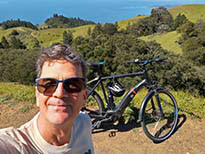* * *
A friend at work told me at least a couple of months ago that he'd had a fairly close encounter with a bobcat at Divide Meadow in Pt. Reyes, and then he told me it happened again just a couple of weeks ago. Yesterday I felt that I couldn't spend another five-day workweek in an office building, so I took the day off to bike up to the meadow, with a plan to look for the bobcat and afterwards ride to the end of the bike trail then hike down to the coast where Arch Rock used to be.
I spotted the bobcat right away. Unfortunately, he was way in the back of the meadow. I watched him for a few minutes and it looked like he was hunting and would likely be in that same spot for a good while. I parked my bike and hiked up along the edge of the woods to try to flank around him, not wanting to make a direct line toward him.
Steller's jays were squawking like crazy as I got near the point I'd last seen the cat, so I sat down and waited to see if he'd show himself. A slight skunk scent wafted over the whole meadow. My shoes and socks were soaked from walking through the dew-covered grass. The cat didn't show up, so after about a half hour I hiked back to my bike and continued the ride.
After checking out the collapsed rubble that once was Arch Rock (it looks much the same as it did last year) and picking three ticks off me, I rode back to Divide Meadow and waited maybe half an hour before the bobcat showed himself again. I caught him pouncing after his prey, but he missed. He looked back at me as if I'd messed him up, then scuttled away in the other direction. I spotted him again a short time later and got the second shot before he strolled into the woods and was gone.
A few people I spoke with at the meadow had all seen the bobcat before and enjoyed a chance to see him again.
There were trillium along the Coast Creek trail, and even a small patch of bleeding hearts.
Seems like everyone is seeing great patches of miner's lettuce this year. The stinging nettle is just getting started and is still just barely knee high.
This is the view up Coast Creek from close to where it used to flow beneath Arch Rock. The old Arch Rock trail no longer has a sign or construction barrier to warn hikers away. Instead, the old trail has been completely decommissioned, covered up with plant material. The sign at the trailhead no longer mentions Arch Rock either. It just points to the Coast Trail.
Three ticks! The first was crawling on the back of my left hand. I plucked him off and checked my legs. Sure enough, I found two more. When I walked back to the main trail I spotted what looked like another tick hanging out near the tip of a dry stalk of grass with its legs splayed out. I put on my glasses to get a better look, and sure enough, there he was. After that I very gingerly continued along the trail to Miller's Point.
From Miller's Point I could see with the aid of binoculars that Alamere Falls was going full blast onto the beach which was covered by a receding high tide. Breakers were splashing right up against the bluffs. I've been thinking about getting out to Alamere Falls again, and just yesterday I tried to reserve a camping space at Wildcat Camp for my wife's spring break next month. No dice. The week is already booked up.
* * *






















































